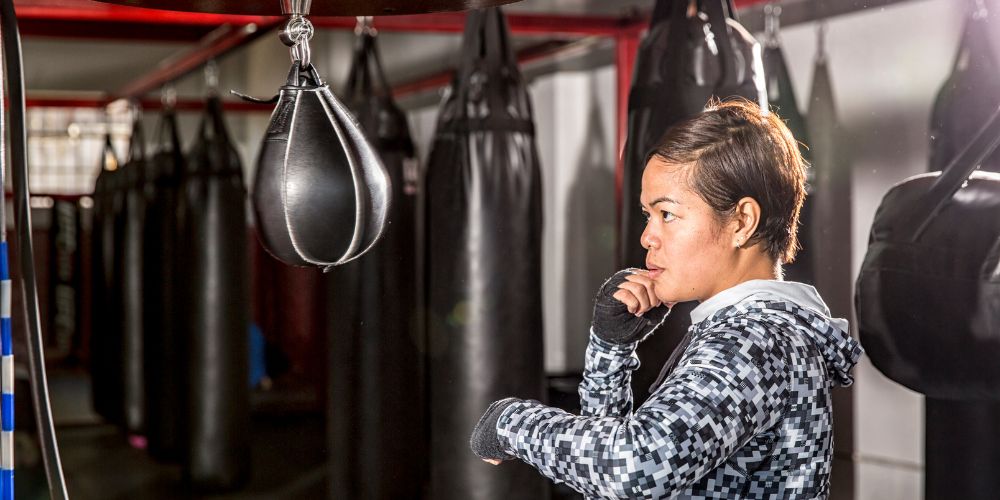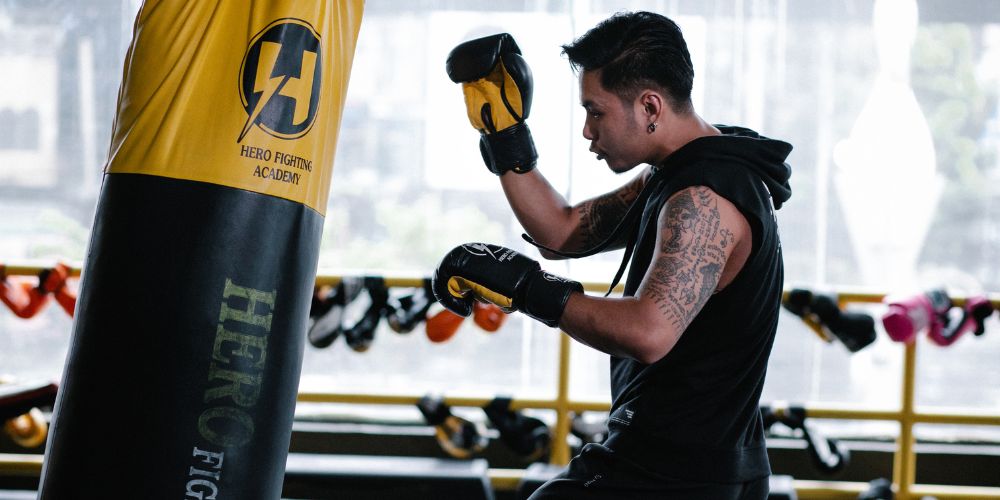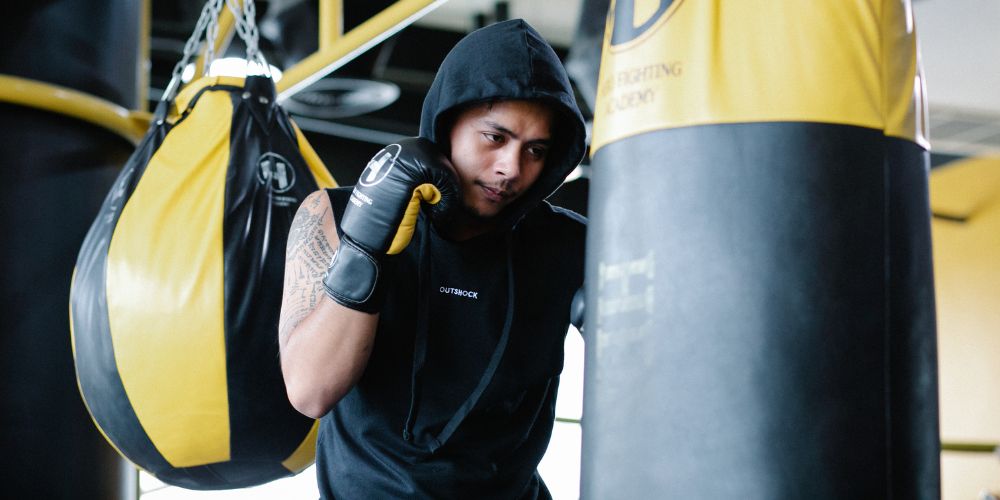As martial artists, fighters, and enthusiasts, hitting things is a big part of our training. Luckily, there is an array of equipment that takes on the role of an imaginary opponent and endures our strikes. But sometimes, the abundance of choice can lead to dilemmas about which bag to use and what benefits you can get from it. A typical comparison is between speed bags and heavy punching bags.
The speed bag is a small tear-shaped bag attached to a platform, and training on it is done by keeping it constantly moving with fast, rhythmic punches. This improves accuracy, timing, and speed in the hands. A heavy punching bag can be used in several ways and for several training purposes, but its most significant benefit is striking power and endurance.
Although they serve very different purposes, the speed bag and heavy bag compete for your training time, and knowing what they bring will help you choose how much time you will spend on each, depending on your current goal.
What Is A Speed Bag

A speed bag is a small, tear-shaped punching bag attached to a platform using a swivel. It is usually filled with air, and when you hit the speed bag, it rebounds quickly, requiring you to have fast and accurate punches and a steady rhythm.
A speed bag is typically mounted on the ceiling or wall at an angle and is used to train speed, accuracy, and coordination.
What Is A Punching Bag

A punching bag is a piece of equipment used for striking, usually as a part of martial art training like boxing, Muay Thai, or MMA. There are different types of punching bags, including speed bags.
The most common punching bags are heavy bags hanging from the ceiling, suspended from a beam, or a ground stand. There are also freestanding punching bags, which use a heavy base and do not need mounting. Speed, double-end, and smaller bags designed for speed and accuracy are also punching bags.
Here are some different models you can choose from:

How to Dominate Every Fight with Raw, Explosive Power No One Can Match
Discover the underground blueprint that has quietly turned MMA hopefuls into legends, using nothing but sheer, brute force and bulletproof conditioning techniques.
- Speed bag
- Double end bag
- Cobra bag
- Hanging heavy bag
- Freestanding heavy bag
- Uppercut bag
- Wall-mounted bag
Often, people use the term punching bag only for heavy bags, even though all of the above can be counted as punching bags. To help you better understand the benefits of the two distinct types, I will continue comparing sped bags only to heavy punching bags.
Benefits Of Training On A Heavy Bag
The heavy bag is a staple of combat sports gyms and an irreplaceable piece of training equipment. Nothing else lets you pummel with full power and not break your hands or the object you hit (although both are completely possible with a standard heavy bag).
The health benefits are immense, which is why many fitness enthusiasts have embraced punching heavy bags, but the primary purpose remains to help you improve your fighting prowess.
Here is exactly how.
Improves Power
The main purpose of a heavy bag is to develop power in strikes. Punching with power depends on multiple factors, but the most significant one remains the ability to transfer as much of your body weight into the punch as possible.
This is only achieved through endless focused repetitions, and the heavy bag is the best piece of equipment to do the reps with full power.
Improves Conditioning
Doing rounds on the heavy bag is tiring. It develops cardio, muscle endurance, and conditioning to hit harder for longer without exhaustion.
Which is one of the critical factors in winning at a higher level of competition. Punching a heavy bag also reinforces the soft tissues and bones in the arms for heavy hitting and conditions the legs for contact.
It’s Very Versatile
As simple as it seems, heavy bags allow you to work on many things. You can improve power, endurance, footwork, distance management, and technique, try out new moves, entertain some different strategies, and man
Types of Heavy Bags

The most significant distinction is between traditional hanging bags and freestanding bags. Suspended bags have been a staple of boxing and martial arts training for centuries because they provide a durable target you can hit with full power safely, are cheap, and are easy to use.
They are cylindrical and weigh anywhere between 70 lbs. up to 200 or even 300 lbs., with a typical 4-foot boxing bag weighing around 100–120 lbs. and a longer 6-foot bag (also called a banana bag) for kickboxing and MMA weighing between 130 and 150 lbs.
Outside of the classic cylindrical shape, there is a lot more variety in the shapes and purposes nowadays. Here are some of the more popular hanging heavy bags:
- Uppercut bag
- Teardrop-shaped heavy bag
- Angled Heavy Bag
- Wrecking ball heavy bag
- Water filled bags
The other major type of punching bag is a freestanding one. They stand on a wide, heavy base filled with water or sand. The base keeps the bag from toppling when hit. They are cylindrical or in the shape of a person, like the famous “Bob” model.
The benefit of freestanding bags is that they do not require mounting and can easily be moved. You get it out, train, and return it to a space where it doesn’t get in the way. But the downside is they are not as versatile as a traditional hanging bag.
They are lighter and cannot be hit with such force; they are less durable, more expensive, and you cannot train as much footwork. Freestanding bags are preferred for home gyms without the space or means to suspend a hanging bag and are loved by practitioners of kicking martial arts styles like taekwondo and karate.
Benefits Of Training On Speed Bag
Speed bags are much more narrowly focused than heavy bags. As the name suggests, the main focus is on speed and accuracy.
Whereas you can do an entire session on a heavy bag, speed bag training will likely take just 2 or 3 rounds. Nevertheless, they have been around for a long time and do not seem to be going away from boxing gyms any time soon.
Here is why:
Increases Speed
Naturally, the speed bag works on punching speed. The punching motion on a speed bag is not the same as on a person, but its constant motion will teach you not to tense up and, by extension, will increase punching speed. And an excellent benefit is that the speed bag is a cool drill to do and makes you look like a pro.
Better Hand-Eye Coordination and Accuracy
Keeping a sped bag rolling is all about rhythm and timing, which are fundamental in boxing, especially past the beginner stages. Speed bags are small and require precision to hit and continuously keep hitting, improving hand-eye coordination, rhythm, and accuracy of your hands.
Build Up Shoulder Stamina
Speed bags are always mounted high, and to keep them moving, you need to keep your hands up all the time and keep punching.
This inevitably builds shoulder endurance and overall stamina. It might not be the optimal cardio work, but a speed bag will raise your heart rate to a respectable level and is another small step in the quest for a bigger gas tank.
Frequently Asked Questions About Speed And Heavy Bags
Does A Speed Bag Make You Stronger
No, punching a speed bag does not make you stronger. But it makes you faster, more coordinated, and better conditioned to throw punches.
Why You Should Use A Speed Bag
The speed bag is a typical boxer exercise rare in other combat sports. But you can and should use it to get the benefits applicable to any combat sport, including fist-slinging.
What Is The Difference Between A Speed Bag And A Punching Bag?
A speed bag is a form of punching bag. A punching bag is a broad term encompassing all types of bags used for punching and kicking, including speed bags.
But it is also used to describe heavy bags specifically, while speed bags and similar equipment like the double-end bag remain separate.
What Is The Difference Between A Heavy Bag And A Punching Bag?
The two terms heavy bag and punching bag are used synonymously. But technically, this is not correct because a heavy bag is but one type of punching bag, just like speed bags, cobra bags, and wall-mounted bags are.
How Can I Increase My Punching Power?
Punching power is determined by many factors, including body mass, speed, and strength, but most importantly, by the ability to create and transfer the highest force in the shortest amount of time.
The key is to transfer force through the whole body, from the feet to the fist. The best way to train and drill proper punching mechanics is by focused, powerful repetitions on a heavy bag.
Summary
Both the heavy and speed bag are great tools proven in time but with different benefits. The heavy bag is much more versatile, can be used to train various aspects of your game, and remains a fundamental part of every fighter training regimen.
The speed bag is much more specialized and preferred by boxers for the accuracy, coordination, and speed it helps improve.
Ideally, you should use both and get the best of both worlds in the ring.

